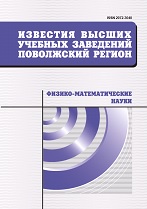|
|
University proceedings. Volga region. Physical and mathematical sciences, 2013, Issue 3, Pages 159–169
(Mi ivpnz400)
|
 |
|
 |
Physics
The creation of the envelope and local frequency of stochastic process on the basis of the oscillator model with fluctuating frequency
V. M. Zhuravlev, P. P. Moronov, S. V. Letunovskiy
Ulyanovsk State University, Ulyanovsk
Abstract:
Background. The interest in creating models of the harmonic oscillator is connected with the possibility of their employment in the applied problems of data processing. The harmonic oscillator with variable frequency (quasi-harmonic oscillator model) is of particular interest. One of the most important advantages of this model is the ability to use well-known mathematical properties of mechanical vibration processes of the harmonic oscillator with slowly varying frequency for signal processing tasks. One of these properties is the existence of adiabatic invariants of such vibration that allow estimating signal amplitude simultaneously with the evaluation of its frequency. The aim of this work is the calculation of the local frequency of the local signal amplitude on the basis of the oscillator model based on the fluctuating frequency with the help of the theory of adiabatic invariants and the maximum entropy method. Materials and methods. Calculation and construction of the envelope and the local process frequency is carried out with the help of the theory of adiabatic invariants. To solve the problem of the random behavior of the process in terms of the model under study the record of the original model in the form of the Riccati equation, its ensemble averaging and application of the maximum entropy method were used. In practice to calculate the local signal frequency the two-stage demodulation procedure is used. They are singling out the signal module and implementing cosine filtration with a window width of more than two periods of the fundamental frequency. Results. Method for estimating the local signal frequency based on the model of an oscillator with a fluctuating frequency is worked out. The calculation scheme that takes into account the random nature of real processes is fully described and grounded. Local frequency is determined by the method of adiabatic invariants. It is shown that there is a need to adjust the computed local signal frequency in this model, and the method of adjusting the calculated local frequency on the basis of the maximum entropy method is suggested. Several test numerical experiments are conducted. Conclusions. The signal adiabaticity condition is satisfied even when the frequency and amplitude of the quasi-harmonic oscillator are changed fast enough, but the changes are local and temporary. The solution of the system of averaged Riccati equations allows getting complete information about the stochastic process. There is a need to adjust the computed local signal frequency in the model of quasi-harmonic signal.
Keywords:
model of an oscillator with a fluctuating frequency, theory of adiabatic invariants, maximum entropy method.
Citation:
V. M. Zhuravlev, P. P. Moronov, S. V. Letunovskiy, “The creation of the envelope and local frequency of stochastic process on the basis of the oscillator model with fluctuating frequency”, University proceedings. Volga region. Physical and mathematical sciences, 2013, no. 3, 159–169
Linking options:
https://www.mathnet.ru/eng/ivpnz400 https://www.mathnet.ru/eng/ivpnz/y2013/i3/p159
|

| Statistics & downloads: |
| Abstract page: | 69 | | Full-text PDF : | 33 | | References: | 21 |
|




 Contact us:
Contact us: Terms of Use
Terms of Use
 Registration to the website
Registration to the website Logotypes
Logotypes








 Citation in format
Citation in format 